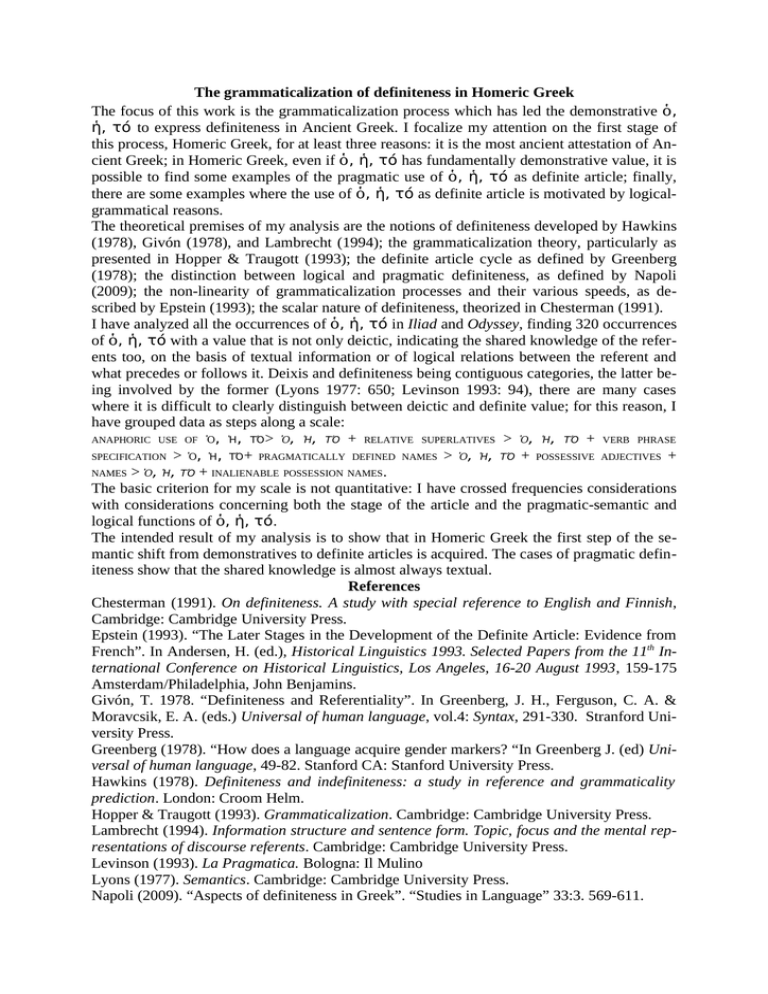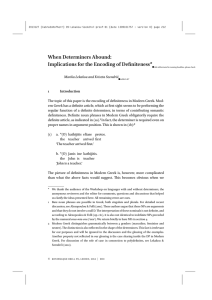The grammaticalization of definiteness in Homeric Greek ὁ,
advertisement

The grammaticalization of definiteness in Homeric Greek The focus of this work is the grammaticalization process which has led the demonstrative ὁ, ἡ, τό to express definiteness in Ancient Greek. I focalize my attention on the first stage of this process, Homeric Greek, for at least three reasons: it is the most ancient attestation of Ancient Greek; in Homeric Greek, even if ὁ, ἡ, τό has fundamentally demonstrative value, it is possible to find some examples of the pragmatic use of ὁ, ἡ, τό as definite article; finally, there are some examples where the use of ὁ, ἡ, τό as definite article is motivated by logicalgrammatical reasons. The theoretical premises of my analysis are the notions of definiteness developed by Hawkins (1978), Givón (1978), and Lambrecht (1994); the grammaticalization theory, particularly as presented in Hopper & Traugott (1993); the definite article cycle as defined by Greenberg (1978); the distinction between logical and pragmatic definiteness, as defined by Napoli (2009); the non-linearity of grammaticalization processes and their various speeds, as described by Epstein (1993); the scalar nature of definiteness, theorized in Chesterman (1991). I have analyzed all the occurrences of ὁ, ἡ, τό in Iliad and Odyssey, finding 320 occurrences of ὁ, ἡ, τό with a value that is not only deictic, indicating the shared knowledge of the referents too, on the basis of textual information or of logical relations between the referent and what precedes or follows it. Deixis and definiteness being contiguous categories, the latter being involved by the former (Lyons 1977: 650; Levinson 1993: 94), there are many cases where it is difficult to clearly distinguish between deictic and definite value; for this reason, I have grouped data as steps along a scale: ANAPHORIC USE OF Ὁ, Ἡ, ΤΌ> Ὁ, Ἡ, ΤΌ + RELATIVE SUPERLATIVES > Ὁ, Ἡ, ΤΌ + VERB PHRASE SPECIFICATION > Ὁ, Ἡ, ΤΌ+ PRAGMATICALLY DEFINED NAMES > Ὁ, Ἡ, ΤΌ + POSSESSIVE ADJECTIVES + NAMES > Ὁ, Ἡ, ΤΌ + INALIENABLE POSSESSION NAMES . The basic criterion for my scale is not quantitative: I have crossed frequencies considerations with considerations concerning both the stage of the article and the pragmatic-semantic and logical functions of ὁ, ἡ, τό. The intended result of my analysis is to show that in Homeric Greek the first step of the semantic shift from demonstratives to definite articles is acquired. The cases of pragmatic definiteness show that the shared knowledge is almost always textual. References Chesterman (1991). On definiteness. A study with special reference to English and Finnish, Cambridge: Cambridge University Press. Epstein (1993). “The Later Stages in the Development of the Definite Article: Evidence from French”. In Andersen, H. (ed.), Historical Linguistics 1993. Selected Papers from the 11th International Conference on Historical Linguistics, Los Angeles, 16-20 August 1993, 159-175 Amsterdam/Philadelphia, John Benjamins. Givón, T. 1978. “Definiteness and Referentiality”. In Greenberg, J. H., Ferguson, C. A. & Moravcsik, E. A. (eds.) Universal of human language, vol.4: Syntax, 291-330. Stranford University Press. Greenberg (1978). “How does a language acquire gender markers? “In Greenberg J. (ed) Universal of human language, 49-82. Stanford CA: Stanford University Press. Hawkins (1978). Definiteness and indefiniteness: a study in reference and grammaticality prediction. London: Croom Helm. Hopper & Traugott (1993). Grammaticalization. Cambridge: Cambridge University Press. Lambrecht (1994). Information structure and sentence form. Topic, focus and the mental representations of discourse referents. Cambridge: Cambridge University Press. Levinson (1993). La Pragmatica. Bologna: Il Mulino Lyons (1977). Semantics. Cambridge: Cambridge University Press. Napoli (2009). “Aspects of definiteness in Greek”. “Studies in Language” 33:3. 569-611.







